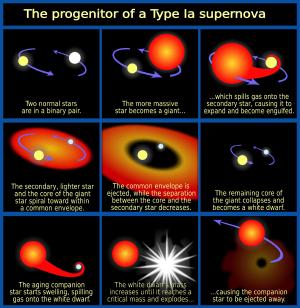Blog
Radio Candle
20 May 2023
 Adam Makarenko/W. M. Keck Observatory
Adam Makarenko/W. M. Keck ObservatorySupernovae are brilliant explosions that can, for a time, outshine an entire galaxy. They come in two broad types: Type I and Type II. Type II supernovae are what are known as core-collapse supernovae. They occur when a massive dying star fuses ever heavier elements in its core until it runs out of energy options and its core collapses under its own weight, which triggers the explosion. Type I supernovae occur when…well, it’s complicated. But we’re learning more thanks to a new observation by radio astronomers.
The original distinction between the types was that hydrogen emission lines could be seen in Type II events, but not Type I. From this, it was thought that Type I was likely involved a cataclysmic explosion of white dwarfs since white dwarfs don’t contain much hydrogen. Over time astronomers that a subgroup of Type I supernovae contained emission lines of ionized silicon during their maximum brightness, and these became known as Type Ia.
You’ve likely heard of Type Ia supernovae because they have a very useful property. They all tend to explode with about the same maximum brightness. This means by observing its maximum apparent brightness, you can determine how far away it is. In astronomy, we call them standard candles, and they play a crucial role in cosmology. The discovery of cosmic expansion and dark energy is due to observations of Type Ia supernovae.
 NASA, ESA and A. Feild (STScI)
NASA, ESA and A. Feild (STScI)They likely occur when a white dwarf has a close stellar companion. As the companion star ages and starts to expand, gas from the star is captured by the white dwarf. This continues until the white dwarf captures too much matter to sustain its own weight, reaching a mass of about 1.4 Suns. At that point the white dwarf collapses, triggering the explosion. Because the critical mass, known as the Chandrasekhar limit, is always the same, these supernovae have similar brightness.
But since Type Ia depend on the accretion of matter onto a white dwarf, they aren’t quite all the same. A few Type Ia are much brighter than usual, with strong iron absorption lines, and there is a variant known as Type Iax, where the white dwarf might not be completely destroyed. So we still aren’t entirely sure how these supernovae are triggered, which is why a recent study is so important.1
The study was just published in Nature, and it describes the first radio observation of a Type Ia supernova. Supernova types are identified by their spectral lines in optical and infrared. Radio observations of Type II supernovae have helped astronomers understand how very large stars end their lives. But we haven’t had radio observations of white dwarf explosions, since they aren’t bright at radio wavelengths.
Then in 2020, the Zwicky Transient Facility Camera at Palomar Observatory captured a supernova named SN 2020eyj. It was unusual because the spectra observations showed the supernova was surrounded by gas rich in helium. Ionized helium emits radio light, so the team observed the supernova at radio wavelengths, and sure enough, observed the event.
This is important because it gives an astronomer a better understanding of the environment leading up to the supernova explosion. In this case, the companion star likely lost most of its mass before the explosion. Some of its material was captured by the white dwarf, but much of it expanded around the stars, creating a helium-rich environment.
With future radio observations, astronomers could understand why Type Ia supernovae come in several variants. This could also help refine their use as standard candles.
Kool, Erik C., et al. “A radio-detected type Ia supernova with helium-rich circumstellar material.” Nature 617.7961 (2023): 477-482. ↩︎